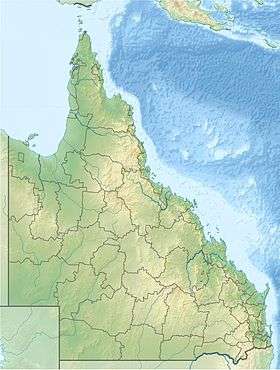Leichhardt River
| Leichhardt | |
| River | |
 Leichhardt River, Mount Isa, ca. 1929 | |
| Name origin: Ludwig Leichhardt | |
| Country | Australia |
|---|---|
| State | Queensland |
| Region | Gulf Country |
| Source | Rifle Creek |
| - location | Selwyn Range, Australia |
| - elevation | 406 m (1,332 ft) |
| Mouth | |
| - location | Gulf of Carpentaria, Australia |
| - elevation | 0 m (0 ft) |
| - coordinates | 17°34′46″S 139°47′37″E / 17.57944°S 139.79361°ECoordinates: 17°34′46″S 139°47′37″E / 17.57944°S 139.79361°E |
| Length | 630 km (391 mi) |
| Basin | 32,878 km2 (12,694 sq mi) |
| Discharge | |
| - average | 69 m3/s (2,437 cu ft/s) |
 Location of Leichhardt River river mouth in Queensland | |
| [1] | |
The Leichhardt River is a river in north west Queensland, Australia.
Course
The source of the river is in the Selwyn Range under Rifle Creek Hill and fed by Rifle Creek approximately 25 kilometres (16 mi) south of the mining town Mount Isa. It runs in a generally northerly direction almost parallel with the Diamantina Development Road until it reaches Mount Isa and crosses the Barkly Highway. It continues in a north easterly direction across the Gulf Country passing through Lake Moondarra past Glenroy Station then through Lake Julius. It then bears east then north again almost parallel with the Burke Developmental Road until crossing it near Nardoo. Continuing north past Augustus Downs to its mouth at the Gulf of Carpentaria.[1] The river is named after the early explorer of Australia, Ludwig Leichhardt.
Catchment
Leichhardt River has a catchment area of 32,878 square kilometres (12,694 sq mi).[2] Primary activities undertaken in the watershed include mining and grazing.
The river is ephemeral and in the dry season the upstream reaches retract to a series of waterholes. The drainage basin and river estuary are in a near pristine condition.[3]
The river is dammed near Mount Isa to form Lake Moondarra. Other storage facilities in the catchment include Julius Dam, East Leichhardt Dam and Rifle Creek Dam.[2] Around 50 kilometres (31 mi) upstream from its mouth are the Leichhardt Falls. As well as Mount Isa, the small community of Kajabbi is located on the river.
The river has a mean annual discharge of 2,179 gigalitres (2.850×109 cu yd).[4]
History
In 2009 Xstrata spent $3 million for remediation work involving the removal of 40,000 tonnes of material from the riverbed.[5]
Fossil remains have been found along the river's course. In 2011 an unidentified ancient marsupial was discovered by paleontologists.[6]
See also
References
- 1 2 "Map of Leichhardt River, QLD". Bonzle Digital Atlas. Digital Atlas Pty Limited. 2015. Retrieved 31 May 2015.
- 1 2 "Water resources - Overview - Queensland: Basin & Surface Water Management Area: Leichhardt River". Australian National Resources Atlas. Department of Sustainabililty, Environment, Water, Population and Communities. 15 June 2009. Retrieved 11 June 2012.
- ↑ "Estuary Assessment 2000: Basin: Leichhardt River". Australian National Resources Atlas. Department of Sustainability, Environment, Water, Population and Communities. 20 June 2009. Retrieved 11 June 2012.
- ↑ "The Land - Overview". Southern Gulf Catchments. Retrieved 31 May 2015.
- ↑ Meera Nambiar (10 November 2009). "Miner spends $3m on river clean-up". ABC News. Australian Broadcasting Corporation. Retrieved 11 June 2012.
- ↑ David Lewis (6 December 2011). "Ancient marsupial skull like 'Planet of the Apes leftover'". ABC News. Australian Broadcasting Corporation. Retrieved 11 June 2012.
External links
![]() Media related to Leichhardt River at Wikimedia Commons
Media related to Leichhardt River at Wikimedia Commons